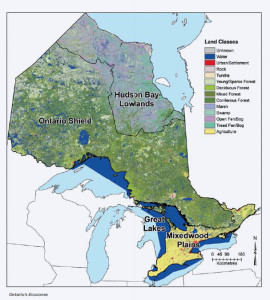Ontario’s Ecozones
 Based on ecology, climate and topography, Ontario can be divided into four ecozones, and each is shared with other provinces and/or American states. Ontario’s four ecozones are summarized here based on information contained in the State of Ontario’s Biodiversity 2010 report (OBC, 2010b).
Based on ecology, climate and topography, Ontario can be divided into four ecozones, and each is shared with other provinces and/or American states. Ontario’s four ecozones are summarized here based on information contained in the State of Ontario’s Biodiversity 2010 report (OBC, 2010b).
The Hudson Bay Lowlands is the northernmost ecozone in Ontario and covers 23 per cent of the province. It is mostly wetlands but also supports boreal and subarctic forests, tundra, tidal marshes and numerous rivers and lakes. Its extensive wetlands provide essential migratory and breeding habitats for birds such as the Snow Goose. In addition, the wetlands act as “carbon sinks,” storing large amounts of carbon. Polar Bear, Lake Sturgeon, Gray Wolf, Woodland Caribou and Wolverine are all found in this ecozone. Only about 0.03 per cent of Ontario’s population (4,275 people in 2006) live here, and most of the landscape is undeveloped. Major human activities in this region include fishing, hunting and trapping. Mining, forestry and hydroelectric development are conducted in the Hudson Bay Lowlands and are likely to increase in the future. Detailed Ecosystem Status and Trends Reports (Technical Report and Key Findings) on the Hudson Bay Lowlands Ecozone are available at http://ontariobiodiversitycouncil.ca/reports-introduction/estr/.
The Ontario Shield is our largest ecozone, covering 61 per cent of the province. About 68 per cent of the area is forested, while lakes, ponds and wetlands make up almost 23 per cent. Its varied topography supports a large variety of ecosystems and species, including Moose, American Black Bear, Beaver and Ring-necked Duck. Coniferous forests of Black Spruce, Balsam Fir, Jack Pine and Tamarack dominate in the northern region. In the south, mixed forests and deciduous forests of tolerant hardwoods (e.g., Sugar Maple and American Beech) are more frequent. About 8 per cent of Ontario’s population (943,313 people in 2006) live in this ecozone. Mining, logging, fishing, trapping, hunting and camping are major activities here.
The Mixedwood Plains is Ontario’s smallest ecozone. Although it covers only 8 per cent of the province, it is home to about 35 per cent of Canada’s population and 92 per cent of Ontario’s population. Its rich soils, moderate climate and central location attracted early settlers. Over the past few hundred years, this ecozone has been changed from forests, wetlands, prairies and alvars to a landscape dominated by agriculture and settlement. Despite this transformation, the Mixedwood Plains is still Canada’s most biologically diverse area, with species such as Sugar Maple, Fowler’s Toad, Fisher and White-tailed Deer. The Carolinian zone (the most southerly portion of this ecozone) has many species that are not found in the rest of Canada. In addition to its substantial population density, the Mixedwood Plains has a high concentration of industry and agriculture and generates more than 25 per cent of Canada’s agricultural production, including many fruits, vegetables and products grown nowhere else in Canada. Detailed Ecosystem Status and Trends Reports (Technical Report and Key Findings) on the Mixedwood Plains Ecozone are available at http://ontariobiodiversitycouncil.ca/reports-introduction/estr/.
The Great Lakes Ecozone, made up of five large lakes and their connecting waterways, contains 18 per cent of the world’s supply of surface fresh water. Parts of four of these lakes lie in Ontario and are shared with the United States; the exception is Lake Michigan, which is wholly contained within the United States. Shaped by glaciers more than 10,000 years ago, each of the Great Lakes reflects that history differently, with coastal areas that are variously composed of bedrock, cobble beaches, sand dunes or alvars. The Ontario portion of the Great Lakes represents 8 per cent of the province. This ecozone supplies 85 per cent of Ontario’s drinking water and includes cold deepwater habitats, shallower nearshore habitats, islands and coastal wetlands. Transportation, fishing and cottaging are the primary human activities on the Great Lakes, and most of the province’s major industries are located on or near their shores. The Great Lakes Ecozone is one of the most ecologically diverse regions in North America, but the biodiversity of the area has been adversely affected by its high population and associated industries.
